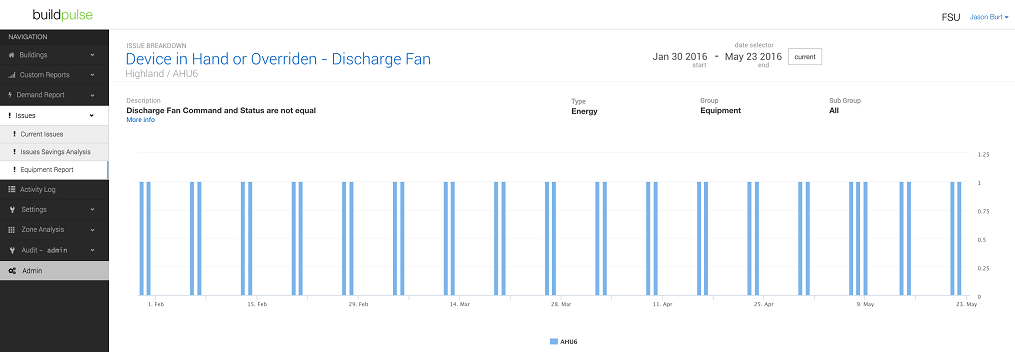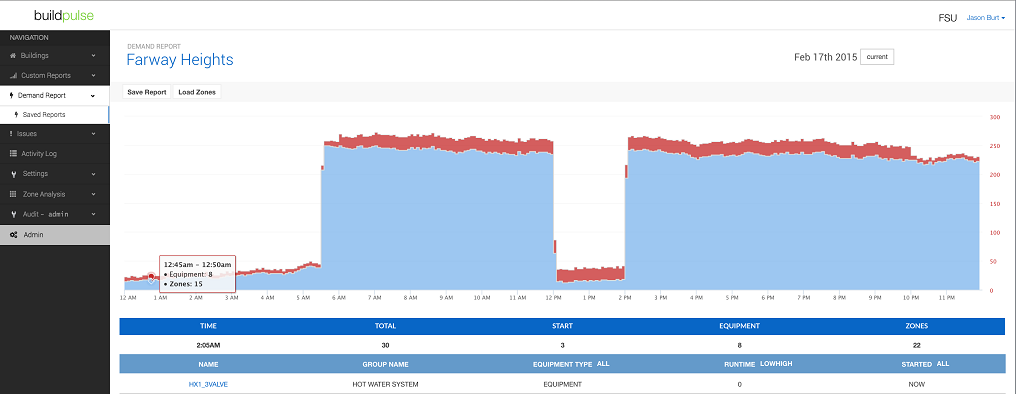|
June 2016
Article
AutomatedBuildings.com
|
[an error occurred while processing this directive]
(Click
Message to Learn More)
|
Data Driven Building Management
The
real secret to success with this data was how we used it. We enabled
teams to engage with one another towards a common goal and get more
done.
|
Jason
Burt
VP Product
Buildpulse
|
Before
starting an analytics company for buildings I lived another life in
the startup world. I had worked in many roles developer, analyst, and
product manager for companies that analyzed data to make operational
improvements and recommendations for companies. We analyzed the
operational logs from companies such as Google, Microsoft, and Walmart
telling them how to improve their sites and increase customer
engagement.
In many ways that space is the future of where analytics in buildings
can be. But though we could measure and analyze anything from what
people clicked on to what they searched for the real secret to success
with this data was how we used it. We enabled teams to engage with one
another towards a common goal and get more done.
What Automation and Software Will
do to the Industry (no robots will not take over)
While I write this article we have processes that are
automatically discovering data in Building Automation Systems. Once
identified the data is automatically standardized to a tagging schema
based on Haystack and ASHRAE standards. This automated process allows a
few people to connect hundreds of buildings a month to a modern
analytics service.
People’s first reaction to this is to worry about robots replacing
them. It makes sense because they often think their value add is
aligning data or shifting through a few controls to find ‘unique’
issues even though the issues in buildings are not new or unique. PNNL,
ASHRAE and many others have documented these.
But what people are missing is that automation unlocks their time.
Facility managers who want the most bang for their buck can focus teams
on specific issues without having to dig through raw data. The GSA, who
recently presented at NFMT’s High-Performance Buildings conference,
estimated that data driven approach to facility management not only
saved them 8-10% in energy but also recovered .20 -.30 a sqft in
operations and management. One customer with 90 buildings had two full
time techs digging through data to look at systems. Over the course of
a year they verified operations in 40 of those buildings. An automated
process can verify operations in all 90 buildings every 5 minutes.
Freeing up that team to fix issues that appear.
Building Better Relationships Using
Data
Modern analytics tools are a feedback loop that help
more than just facility teams. Commissioning agents and controls
contractors that once spent days trying to align data and setup basic
trends are now spending that time working with their customers on
fixing issues in their buildings. They have targeted reports that show
areas that schedules, set points, and sequences can be adjusted. They
are creating value add services, no longer spending their valuable time
just making sure the database is online or the data is correct.
Continuous monitoring has allowed them to make the transition from
transactional to relational services. They are able to discover things
such as issues that occur outside of occupied hours that are often not
caught. For example weekend sequences that the Monday through Friday
team would never catch.

The service providers use automated analytics as a diving off place for
customer engagement. They check up on the low hanging issues that
require no capital expense to follow up with larger improvements that
fall into capital management.
Choose Your Key Performance
Indicators
If you're bringing data and analytics into an
organization it is good to start with a conversation around goals.
Improving operations while maintaining comfort for tenants is
achievable but it requires visibility into both. Once these are
established matching the goals to KPIs (Key Performance Indicators)
will give you a guide to where you should gather data. We normally look
at comfort along with energy savings which we break into equipment
runtime and performance.

Your KPI’s should show you areas for improvement. They are not
dashboards that show graphs that are disconnected from the underlying issues. While
energy and EUI are good starting points, they can lead to a false sense
of completeness. We had one customer who had done a great job of
improving performance in their buildings. They had a number of
buildings with 90s in energy star ratings, after we installed there
were still roughly 10% savings in those buildings. All low hanging
fruit.
Below is a common occurrence, equipment running 24/7 so if you were to
attempt regression analysis on the kwh data you would miss it.

IOT is Short for a Lot More Data and More Systems to Maintain
[an error occurred while processing this directive]The sheer amount of data and information coming from
systems can be daunting. A 100,000 sqft building can have tens of
thousands of data points. Summed over a portfolio of buildings keeping
track of and maintaining that data can be daunting.
In addition, more affordable hardware is enabling more of the building
stock to come onto the market increasing the amount of data to shift
through. Where once controls made economic sense in larger buildings
smaller buildings are becoming more available.
While the number of sensors and controls being installed is increasing
the size of most facility teams is not. To successfully mange these
additional systems a clear plan needs to be in place. Sensors should be
prioritized based on the impact they have on systems and a monitoring
plan should be set to automatically check these sensors for variances
or issues. For example the impact of an Outdoor Temperature sensor can
be significant compared to an individual thermostat. Having an
analytics service take care of monitoring and prioritization allows
teams to increase time between manual service while reducing the impact
of faulty sensors.
Analytics With a Purpose
There are large opportunities to leverage data and
analytics in building operations, but to be successful one has to
remember what automation and analytics are for. Modern analytics
services should reduce the amount of time teams spend looking for
issues or verifying things are running within expected bounds. They
should help teams improve their workflow and provide assistance in
prioritizing issues.
Cause at the end of the day it’s the team that makes the impact.
footer
[an error occurred while processing this directive]
[Click Banner To Learn More]
[Home Page] [The
Automator] [About] [Subscribe
] [Contact
Us]


